|
Published on Archi.ru (https://archi.ru) |
|
| 24.03.2021 | |
|
The Red Building |
|
|
Natalia Koriakovskaia, Julia Tarabarina |
|
| Architect: | |
| Andrey Romanov | |
| Ekaterina Kuznetsova | |
| Studio: | |
| ADM | |
|
The area of Novoslobodskaya has received Maison Rouge – an apartment complex designed by ADM, which continues the wave of renovation, started by the Atmosphere business center, from the side of the Palikha Street. The Palikha Street is very quiet and very “Moscow” in its character: probably, this feeling appears thanks to the tramway lines and the surrounding low-rise construction, interspersed with rather green yards. The street does not have a continuous redline – it is now and then interrupted by a little park, or a parking lot, or just by a vacant space. Thus, the new premium-class residential complex Maison Rouge, designed by ADM Architects for the developer company MR Group, is plainly visible from Palikha, even though it does step back from the redline, its glass-and-brick confidently assets itself against the background of the neighboring buildings.  “Maison Rouge” residential complexCopyright: Photograph © Yaroslav Lukyanchenko / provided by ADM architects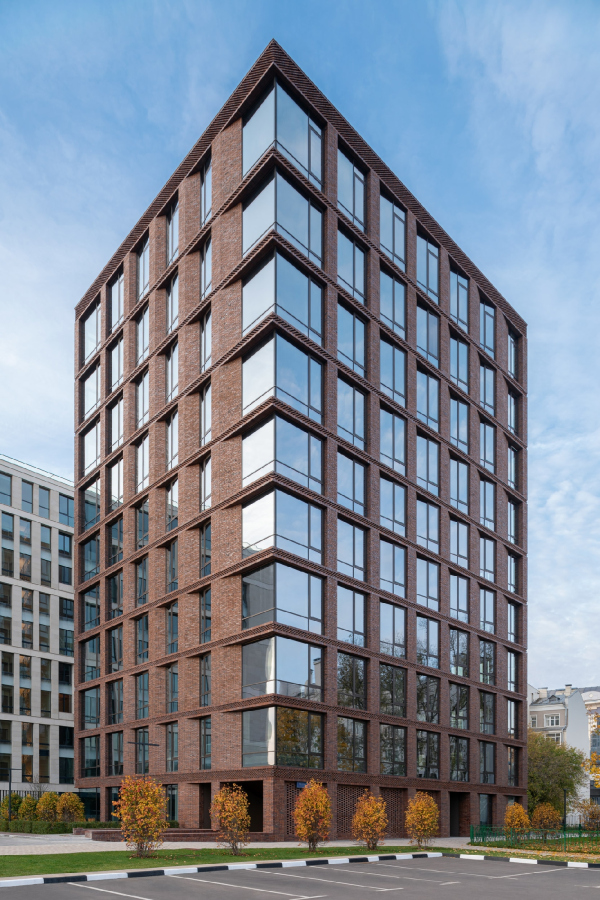 “Maison Rouge” residential complexCopyright: Photograph © Yaroslav Lukyanchenko / provided by ADM architectsThe immediate context essentially consists of one building, designed and built by the same authors, Andrey Romanov and Ekaterina Kuznetsova, and coated by light-colored stone – the Nouveau building of the residential complex Renome. It should be said that ADM Architects have been working with the city area, which lies between the Palikha, Sushchevskaya, and Novoslobodskaya streets, for already about a decade – they started in 2011 from reconstructing the buildings of the XIX weaving factory for the Atmosphere business center, then Renome appeared. Maison Rouge is the most recent building here – its project appeared in2017. “This is quite an independent project – Andrey Romanov emphasizes – It’s got a different client, and a different architectural solution.” The house does indeed look more modern against its context: the crystal-clear volume, livened up by asymmetric “gradient” of the facade verticals, large windows reaching to the floor, expensive German bricks, little and of varying tones, with inclusions of textured masonry – all of these do not leave a shadow of doubt in the relevance of the architectural solution. 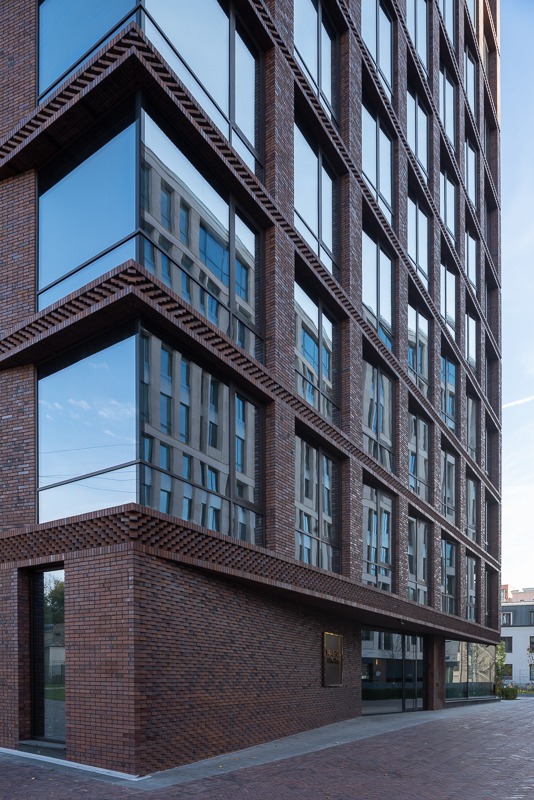 “Maison Rouge” residential complexCopyright: Photograph © Yaroslav Lukyanchenko / provided by ADM architects “Maison Rouge” residential complexCopyright: Photograph © Yaroslav Lukyanchenko / provided by ADM architectsUnlike in the neighboring building, which belongs to the Renome housing complex, the Maison Rouge windows are not grouped in pairs vertically, and the game of plastique unfolds in a quite different direction. The stability of the form is ensured by the thin horizontals of intermediate belts between the floors: they all are accentuated by the textured herringbone masonry, which reacts perfectly well to the contrastive play of light and shade – a solution that is a direct opposite of the smooth intermediate friezes of Renome. Belts of equal height dissect the floors at clear and regular intervals; only two belts are thicker – the topmost and the bottommost one, the latter corresponding to the floor of the second story. 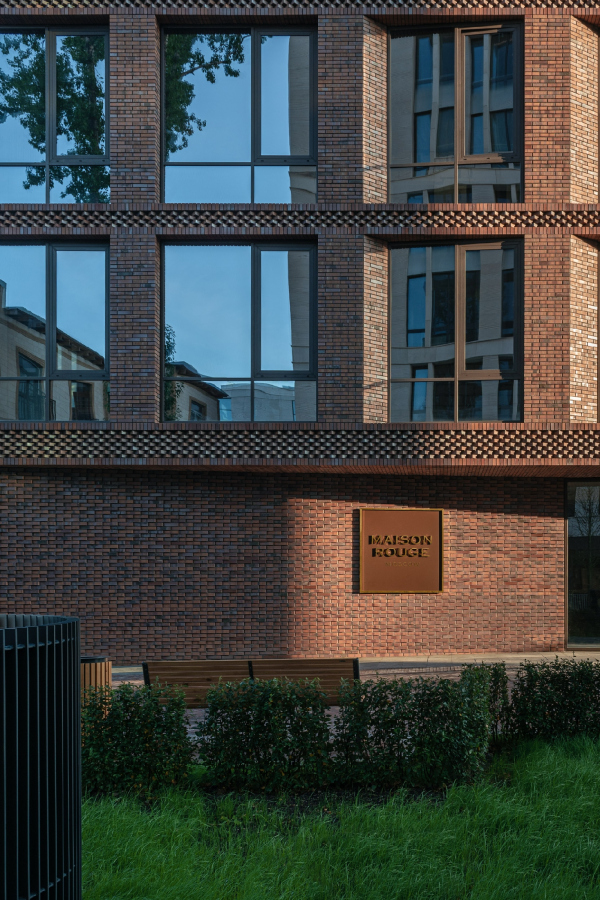 “Maison Rouge” residential complexCopyright: Photograph © Yaroslav Lukyanchenko / provided by ADM architects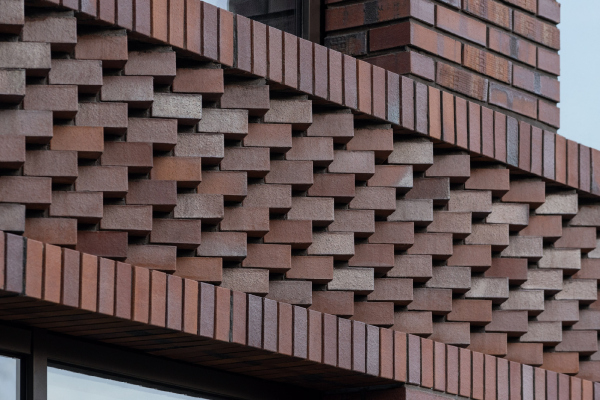 “Maison Rouge” residential complexCopyright: Photograph © Yaroslav Lukyanchenko / provided by ADM architectsThe basement mold that you would normally expect on the ground level is virtually nonexistent, or, rather, it is minimal, only adjusting the fluctuations between the floor level on the inside and the gradually lowering pavement on the outside: the glass of the first floor literally grows from the ground – this technique makes it possible to build the visual connection between the inner space of the lobby with the world outside and present the volume as light and ethereal. 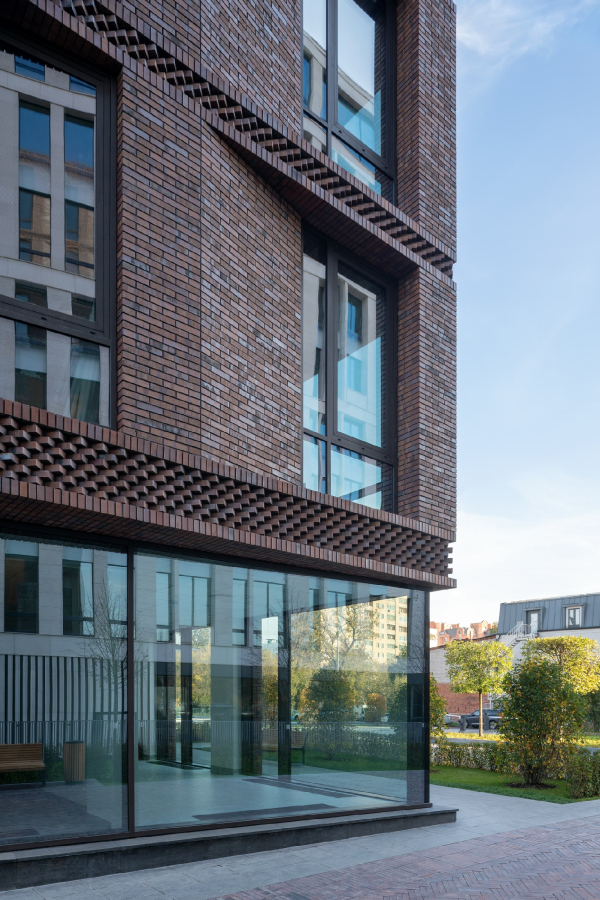 “Maison Rouge” residential complexCopyright: Photograph © Yaroslav Lukyanchenko / provided by ADM architects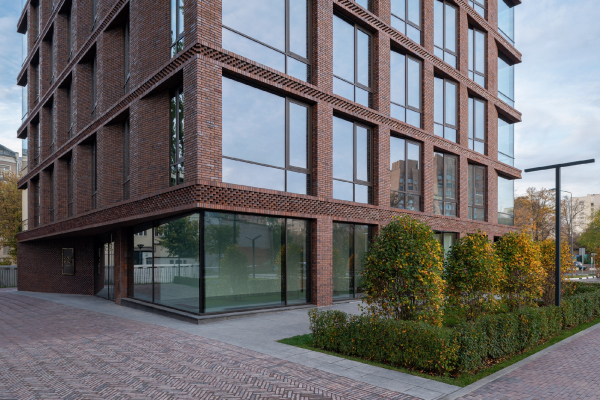 “Maison Rouge” residential complexCopyright: Photograph © Yaroslav Lukyanchenko / provided by ADM architectsThe dynamic plastique is ensured by the verticals. If we are to look at each of the walls en face, we will see that on the left side the width of the piers increases, a single-sided chamfer appears, which gradually becomes less and less sloping, and the windowpane, growing narrower, also turns at an angle – a peculiar wave runs over each of the facades, which, nonetheless, does not violate the external surface of the wall. The plan of the building looks like a rectangle of very soft proportions, almost a square, and this is the reason why the facades are almost identical: there are five piers on the lateral facades, and six on the longitudinal ones. The direction of the faceted wave is also the same everywhere – it circles the perimeters of the building, enshrouding it in a peculiar “vortex”. But then again, this can only be seen on the plan. 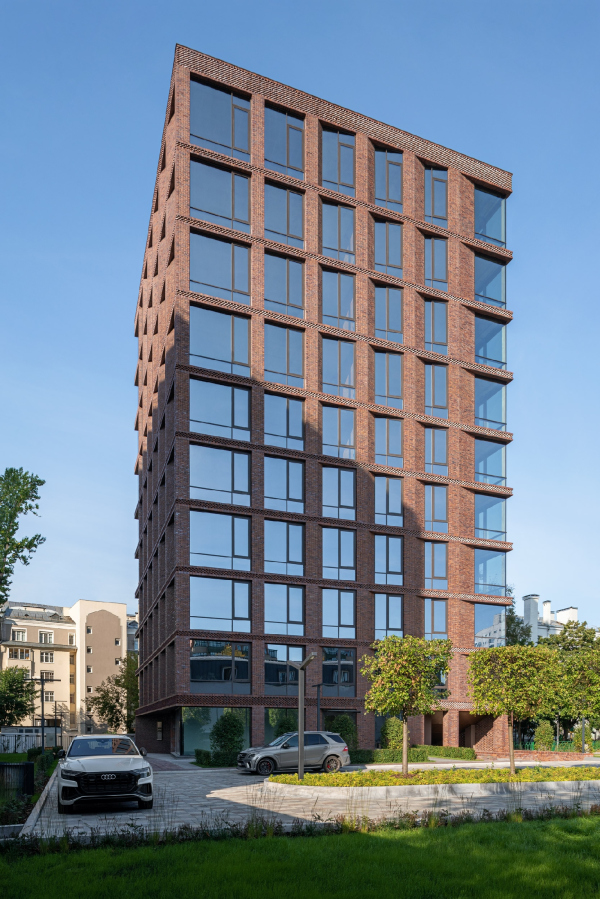 “Maison Rouge” residential complexCopyright: Photograph © Yaroslav Lukyanchenko / provided by ADM architects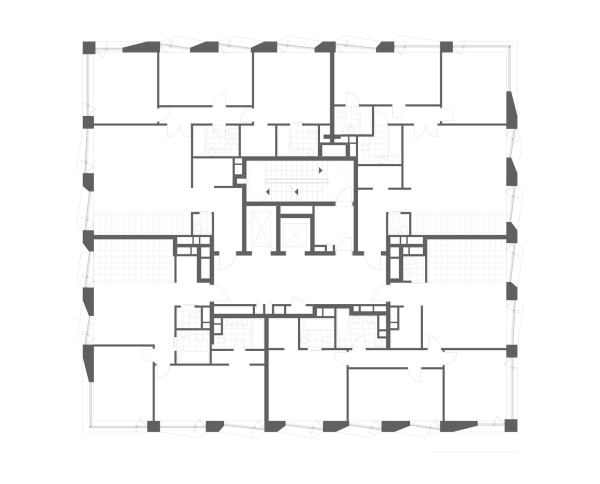 Plans of the 4-8 floors. “Maison Rouge” residential complexCopyright: © ADMThe corners of the building, however, which could also have been designed identical, got a diagonal difference – two of them are “fastened” with a vertical mold, and two others are completely made of glass. If we are to take a look at the plan once again (overlooking some minor technical details), we could see that it is composed of two identical right-angled triangles, turned to one another at a 180-degree angle, and “joined” along their hypotenuses, the sharp angles constituting the halves of the glass corners of the house, the floor plan consisting of two similar larger and two similar smaller apartments. This geometrical game of figures of similarity gives the design some additional internal logic. The northeast open corner is turned to the Palikha Street and functions a little bit like a facade accent – an element that attracts the gaze of the passers-by. “Maison Rouge” residential complexCopyright: Photograph © Yaroslav Lukyanchenko / provided by ADM architectsWhen looking at the facades from the pedestrian’s position, the “wave” rather works for a variety of perception from different angles: sometimes the glitter of glass is more noticeable, sometimes the brick surfaces. When viewed from the bottom up, the edges are projected onto the protrusions of the intermediate floors in a zigzag pattern, making the observer take interest in the internal logic of the sequential changing pattern. “Maison Rouge” residential complexCopyright: Photograph © Yaroslav Lukyanchenko / provided by ADM architectsAnd the essence of the facade plastique in this case consists in finding the optimal balance between the weightless glass and the sturdy brick “matter”, bringing them harmoniously together. The brick chamfers, so important for facade plastique, get a response in the design of the entrance group. It is turned to the south and to the center of the block, which allowed maximum illumination of the quiet area in front of the door with sunlight reflected by the stained glass window. The entrance itself is a triangular niche stretching the entire width of the facade: on the left, there is an extended bevel with embossed brickwork, on the right it is mostly glass. The brick slope is reflected in the glass and, when viewed from a certain angle, reality and reflection add up to form a sharp illusory “nose”. 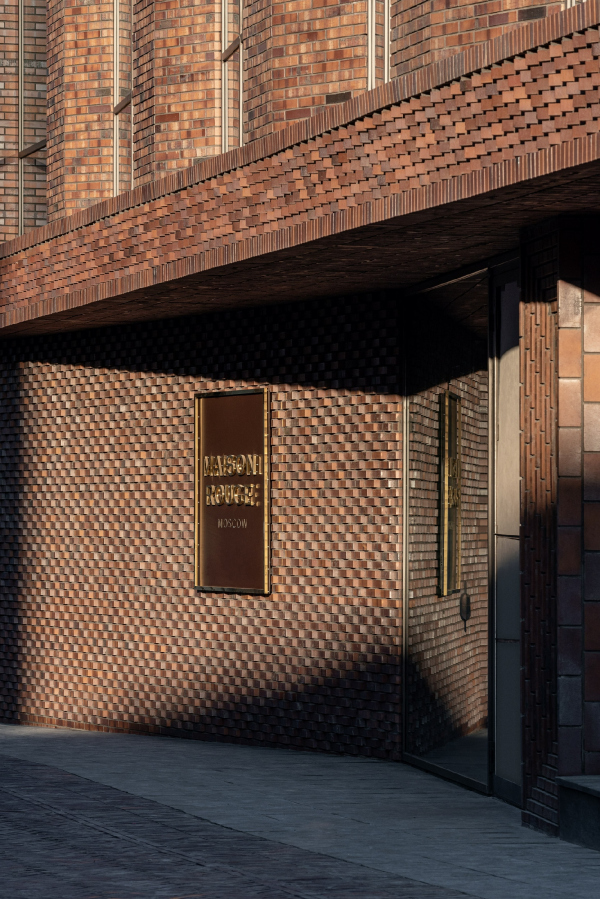 “Maison Rouge” residential complexCopyright: Photograph © Yaroslav Lukyanchenko / provided by ADM architects “Maison Rouge” residential complex. Location planCopyright: © ADM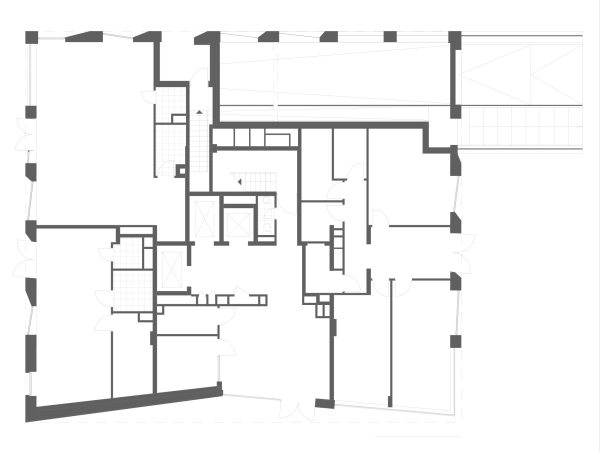 Plan of the 1st floor. “Maison Rouge” residential complexCopyright: © ADM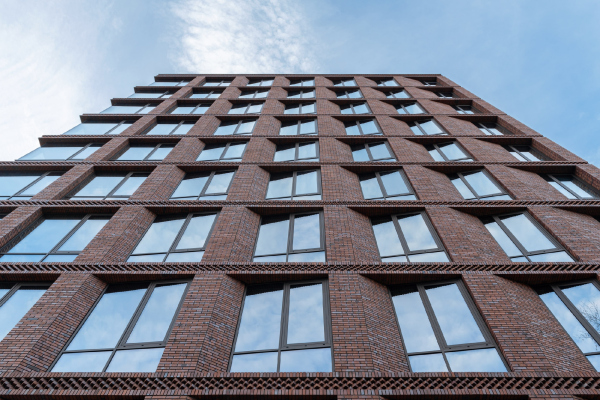 “Maison Rouge” residential complexCopyright: Photograph © Yaroslav Lukyanchenko / provided by ADM architects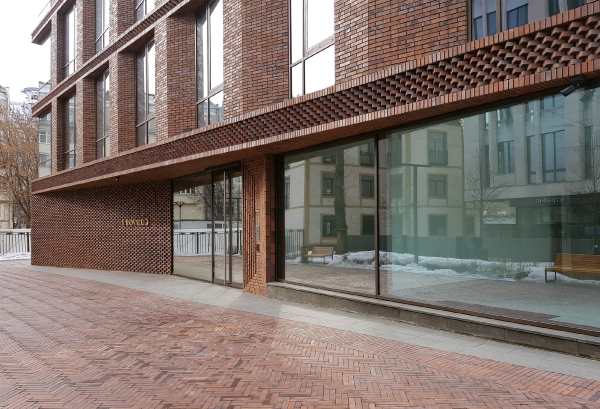 The main entrance. “Maison Rouge” residential complexCopyright: Photograph: Archi.ruOn the opposite, northern, side there is an entrance to the ramp leading to the underground parking garage; it is covered with a lattice of bricks arranged in a checkerboard pattern. The brick itself – an expensive German clinker mounted on a subsystem – is a separate topic, since in this case it is used as the main material and is responsible for the building’s name (Maison Rouge means Red House), as well as for the texture, imagery, and for the expensive “glamorous” look of the facade, glittering in the sun with metallic splashes in unison with the glitter of the window panes. The color of the brick was originally planned as a wine-red; in the implemented version it took on a slightly more muted terracotta shade, but due to the different colors and inclusions, in different lighting conditions, it looks sometimes brown, and sometimes pink. 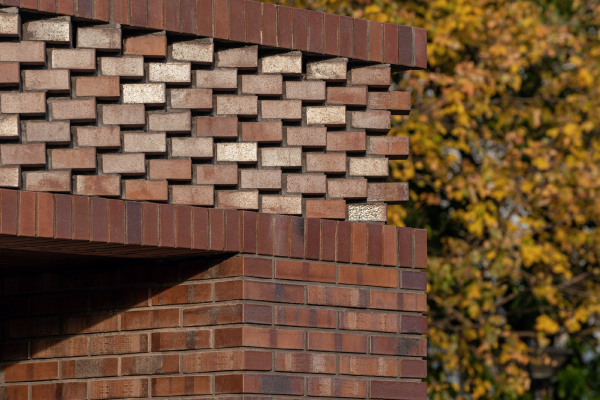 “Maison Rouge” residential complexCopyright: Photograph © Yaroslav Lukyanchenko / provided by ADM architects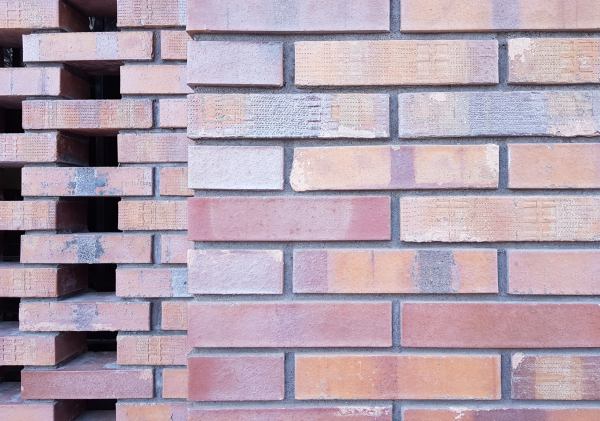 “Maison Rouge” residential complex / masonry examplesCopyright: Photograph: Archi.ru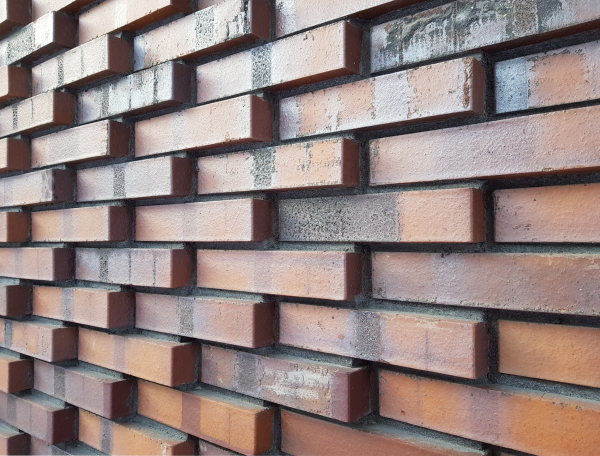 “Maison Rouge” residential complex / masonry examplesCopyright: Photograph: Archi.ru “Maison Rouge” residential complex / masonry examplesCopyright: Photograph: Archi.ru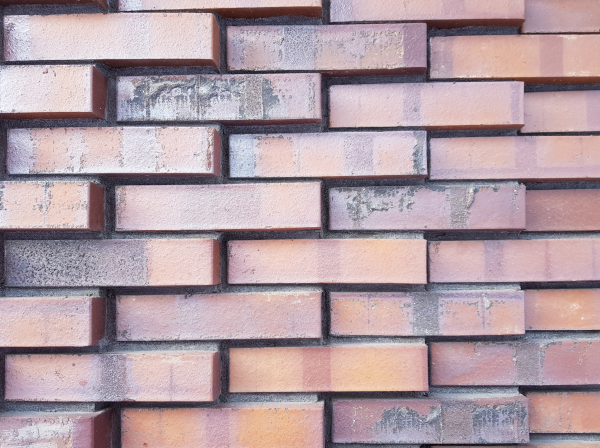 “Maison Rouge” residential complex / brickwork examplesCopyright: Photograph: Archi.ruThe brick also accentuates the contextual nature of the building – all the old Moscow houses around it, although stuccoed, are brick on the inside. At the same time, if we are to look at Maison Rouge from the Héritage building of the Renome residential complex, we cannot but notice some parallels between these two brick volumes: they both flank a volume of light stone, forming a well-orchestrated composition, united by the same authorship. But then again, Maison Rouge is separated from the neighboring Renome both by a fence and a slight (about one meter) height drop. There is no single in-block space forming between them, even though you can indeed walk through the block from end to end (we will note in passing that the guards of the Renome residential complex recently stopped an attempt by one of the authors of this article to pass through the grounds from Palikha to Novoslobodskaya; but the Maison Rouge site is open to the city and is perceived as pleasant and friendly: security here is provided by other, more modern means). The new project is essentially an apartment building, which does not necessitate for a highly developed yard, and the surrounding territory is quite small. However, there are city sights adjoining to it, which were improved in accordance with the municipal program. The architects proposed initial sketches, the department implemented them, and the authors are generally satisfied with the result – the house eventually acquired, in addition to its own small (0.14 hectare) plot, a pleasant environment of trees, bushes and benches. The territory from the Palikha side is not fenced off, and the building, in a win-win situation, merges with the city space. On the other hand, the red Klinker paving around the Maison Rouge refers to its own landscaping and, on the one hand, marks the boundaries of the plot, and on the other, it figuratively supports the main theme: a brick house is surrounded by a brick pavement; walking around it, we also feel the Klinker bricks underneath our feet, and the city begins to feel like a church floor of the XVII century, paved in a “herringbone” pattern. But then again, all the historical and contextual associations are no more than conditional, and are essentially based on the sheer fact of working with the brick texture. But even the Klinker brick does not leave a shadow of doubt in the contemporary nature of the solution. Furthermore, the very fact that the architects opted for this kind of brick and carefully worked with it, creating the brick “skin” of the house, where each turn of the brickwork demonstrates the integrity of the terracotta texture is part of the trend of Moscow architecture of the last 15 years. So, the building is “in trend”, and, in addition, it formed a confident accent both from the side of the Palikha Street, where Maison Rouge fills in a small lacuna, and on the side of the Novoslobodskaya Street, where the volume is plainly visible in the break of the redline, in the stead of the former marketplace. This, basically, is what the whole project was all about: about bringing some compositional logic to the dense and chaotic city block, and expanding the landscaped public space. |
|

